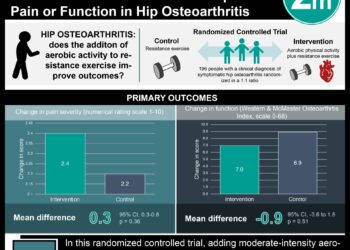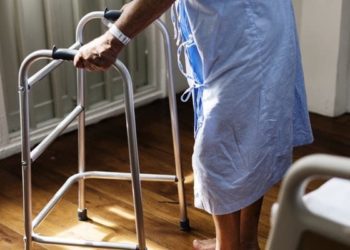Wellness Check: Exercise
Physical activity following a deep vein thrombosis reduces the severity of post-thrombotic syndrome
1. This systematic review found that early mobilization in the acute phase following a deep vein thrombosis (DVT) was associated with a significant reduction in post-thrombotic syndrome (PTS) severity after two years and improvements in quality of life and pain reduction.
2. Furthermore, none of the included studies reported an increased risk of PTS due to physical activity.
Evidence Rating Level: 1 (Excellent)
Post-thrombotic syndrome (PTS) is a set of symptoms related to impaired venous outflow that commonly occurs following a deep vein thrombosis (DVT). PTS is a significant burden on patients, resulting in a lower quality of life (QoL) and increased medical needs. Many fear that exercise in the acute phase following a DVT can be harmful. Previous findings have suggested that exercise following a DVT can help prevent the development of PTS. Still, further research is necessary to evaluate the long-term effects of exercise post-DVT on symptoms and PTS. This systematic review sought to assess the direct and long-term effects of physical activity in patients following a DVT.
Of 3,154 identified records, 10 studies were included from July 2007 to March 2022. Studies were included if they were published in English and investigated the effects of physical activity on the incidence of PTS, indicators of PTS, or QoL in DVT patients. Studies were excluded if more than half of their study populations had causes of chronic venous insufficiency other than a DVT. The study quality was assessed using the GRADE framework, and the review was carried out according to PRISMA guidelines. The primary outcome was the association between physical activity and the incidence or symptoms of PTS.
The results demonstrated three main types, timings, and durations of exercise following a DVT: early mobilization in the acute phase, short-duration exercise one year post-DVT, and prolonged exercise during follow-up after a previous DVT. Overall, early mobilization in the acute phase was associated with a significant reduction in PTS severity after two years and also resulted in improvements in QoL and pain reduction. Prolonged exercise was also associated with improvements in QoL and venous insufficiency. Furthermore, none of the included studies reported risks of worsening symptoms or PTS related to physical activity. However, the review was limited by many of the included studies using surrogate markers for PTS, such as joint flexibility, which is not necessarily associated with PTS. Nonetheless, this study suggested that physical activity is a safe and effective method for improving symptoms and decreasing the risk of PTS following a DVT.
1. In this cluster randomized controlled trial, children who received a daily physical activity (PA) intervention showed improvements in waist-to-height ratio, cardiorespiratory endurance, lower body muscle strength, lower body muscle endurance, and flexibility compared to the control group.
2. Furthermore, children without sports club membership showed more pronounced improvements in cardiorespiratory endurance and flexibility, indicating that this population may benefit the most from daily PA in school.
Evidence Rating Level: 1 (Excellent)
Physical activity (PA) is an important determinant of fitness and can have various long-term health benefits, especially in children and adolescents. However, due to decreases in outdoor play and the effects of the COVID-19 pandemic, there has been a substantial drop in the amount of PA that children and adolescents achieve. One strategy for improving overall population PA levels is implementing PA programs in schools. However, these require significant time, spatial, and human resources. Thus, this study aimed to evaluate a PA program that did not require additional spatial resources or curriculum changes on health-related fitness parameters in primary school children.
This cluster randomized controlled trial included 412 children (n=24 classes) attending fourth grade in Austria in September 2021. Participants were included if they were 8-12 years old and had no physical limitations preventing them from performing the fitness tests. The 24 classes were randomly assigned to either the intervention or control group. The intervention group received two standard physical education (PE) classes delivered by teachers but supported by external coaches. On the remaining three school days, students learned academic content combined with specific movement activities. Additionally, once a week, students in the intervention group received PA activities as homework. The control group received the usual school curriculum consisting of two 50-minute PE classes weekly. The study went on for the duration of one school year. Baseline measurements were conducted in September 2021, and follow-up measurements were collected in June 2022. A series of fitness tests were used to assess health-related fitness, including a 6-minute run for cardiorespiratory endurance, a standing long jump for lower body muscular strength, and more. The primary outcome was the difference in anthropometric measurements and fitness parameters between the intervention and control groups.
The results demonstrated that the intervention group exhibited a significant improvement in wait-to-height ratio, but not body mass index, compared to the control group. The intervention group also showed improvements in cardiorespiratory endurance, lower body muscle strength, lower body muscle endurance, and flexibility compared to the control group. Furthermore, for those without sports club membership, there were pronounced improvements in cardiorespiratory endurance and flexibility in the intervention group compared to the control. However, the study was limited by the lack of data on important covariates, such as nutrition, which may have influenced the results. Nonetheless, the study suggested that a daily PA program delivered in schools can significantly improve health-related fitness measures, especially in children without sports club membership.
Elements of the built environment influence physical activity behaviors in older adults
1. In this systematic review and meta-analysis, traffic safety and destination accessibility were the factors of the built environment most significantly associated with physical activity (PA) behavior in older adults.
2. However, mixed land use and the quality of pedestrian and commercial facilities were factors of the built environment that were not associated with PA behaviors in older adults.
Evidence Rating Level: 1 (Excellent)
Physical activity (PA) has several health benefits, especially in older populations, which can promote improvements in mental and physical function. It is well known that the built environment influences PA behavior. However, the exact role that the built environment has on PA behaviors in older adults remains poorly understood. Therefore, this systematic review and meta-analysis sought to evaluate the relationship between the built environment and the PA behaviors of older adults to inform policymakers and city planners and help promote PA in older populations.
Of 1,088 identified records, 16 studies were included from database inception to January 2022. Studies were included if they were cross-sectional studies investigating the role of the built environment on PA behaviors in older adults without cognitive impairment. Studies were excluded if they were case reports or reviews or had missing or incomplete data. The study quality was assessed using an 11-item evaluation recommended by American healthcare quality and research institutions. The review was carried out according to PRISMA guidelines. The primary outcome was the odds ratio (OR) of engaging in PA based on various built environment factors.
The results demonstrated that traffic safety, destination accessibility, aesthetics and greenery of sports venues, and building density were positively associated with PA behaviors in older adults. There was no association between mixed land use or the quality of pedestrian or commercial facilities on PA behaviors in older adults. However, the study was limited by not considering other aspects of the built environment, such as accessibility of PA facilities and weather conditions, which may impact PA activities. Nonetheless, the current study provided insights into factors of the built environment that should be considered to enhance the PA behaviors of older adults.
Image: PD
©2023 2 Minute Medicine, Inc. All rights reserved. No works may be reproduced without expressed written consent from 2 Minute Medicine, Inc. Inquire about licensing here. No article should be construed as medical advice and is not intended as such by the authors or by 2 Minute Medicine, Inc.







